Multiple Choice
Identify the
choice that best completes the statement or answers the question.
|
|
|
1.
|
A system is:
a. | a group of items that work independently | c. | a plan that organizes all parts of
a unit | b. | a series of organs that work in a related manner | d. | an organized group of related units that form a
whole |
|
|
|
2.
|
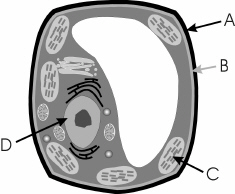 Letter
“C” represents the ____________ in a plant cell.
a. | cell wall | c. | cell membrane | b. | nucleus | d. | chloroplast |
|
|
|
3.
|
1)  2)  3)  4)  Which item above is the source of power for
photosynthesis?
|
|
|
4.
|
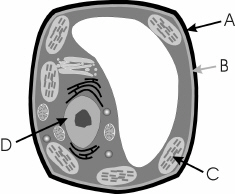 Which list below identifies (in order) the
chloroplast, the nucleus and the cell wall of a plant
cell?
a. | c,d,a | c. | a,b,c | b. | c,d,b | d. | d,c,a |
|
|
|
5.
|
One major difference between plant and animal cells is:
a. | plant cells have no nucleus | c. | animal cells are
larger | b. | animal cells have no chloroplast | d. | plant cells have an extra
membrane |
|
|
|
6.
|
A system is:
a. | a group of items that work independently | c. | a plan that organizes all parts of
a unit | b. | a series of organs that work in a related manner | d. | an organized group of related objects that form
a whole |
|
|
|
7.
|
Which body system is the control system sending information for all the other
systems?
a. | circulatory | c. | nervous | b. | immune | d. | reproductive |
|
|
|
8.
|
Which part of the cell is where photosynthesis takes place?
a. | nucleus | c. | vacuole | b. | chloroplast | d. | cytoplasm |
|
|
|
9.
|
Where can we find the chlorophyll in a plant cell?
a. | nucleus | c. | cell wall | b. | chloroplast | d. | cell membrane |
|
|
|
10.
|
The substance in plant cells call chlorophyll:
a. | contains the nucleus in cells | c. | helps plant cells digest
food | b. | makes the cell expand | d. | makes plants green |
|
|
|
11.
|
In photosynthesis, a plant uses sunlight, carbon dioxide and water to make a
food called_________:
a. | chlorophyll | c. | photostarch | b. | glucose | d. | largesse |
|
|
|
12.
|
The idea that you and your mother have many similar physical traits can be
explained by the concept of ____________.
a. | inheritance | c. | heredity | b. | offspring | d. | family |
|
|
|
13.
|
The concept of ____________ explains why both you and your father have black
hair.
a. | family relations | c. | nature | b. | heredity | d. | offspring |
|
|
|
14.
|
According to the concept of heredity, if your mother and father are tall, you
will be:
a. | short because the genes are already used up by your parents | c. | average height
because statistics say averages must be maintained | b. | average height because children are usually
shorter than their parents | d. | tall because they pass their genes on to you |
|
|
|
15.
|
Which sequence below best explains the process of photosynthesis?
a. | plants use oxygen to create chlorophyll and then use water to attract the sun light
so that carbon dioxide and chloroplast can be created | c. | plant gathers sunlight, plant
gathers water, plant expels oxygen, plant uses chlorophyll in the chloroplast to create sugars
(glucose) for food, plant gathers carbon dioxide | b. | plant gathers water,
plant gathers carbon dioxide, plant gets sunlight, plant uses chlorophyll in the chloroplast to
create sugars (glucose) for food, plant expels oxygen | d. | After the sun shines, plants
“breathe” oxygen to create space for photosynthesis, then plants gather water and carbon
dioxide the fill their chloroplast with chlorophyll |
|
|
|
16.
|
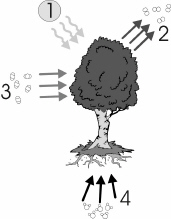 What element necessary for photosynthesis comes from
# 4? a. | carbon dioxide | c. | sunlight | b. | water | d. | air |
|
|
|
17.
|
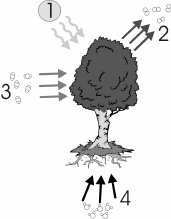 What element necessary for photosynthesis comes from
# 1? a. | carbon dioxide | c. | sunlight | b. | water | d. | air |
|
|
|
18.
|
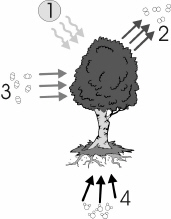 What element necessary for photosynthesis comes from
# 3? a. | carbon dioxide | c. | sunlight | b. | water | d. | air |
|
|
|
19.
|
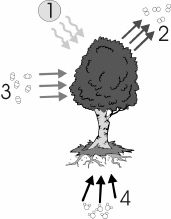 What element is produced by photosynthesis and is
shown in # 2? a. | carbon dioxide | c. | sunlight | b. | water | d. | oxygen |
|
|
|
20.
|
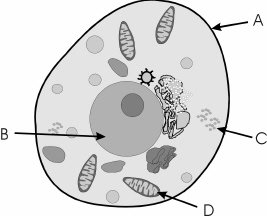 Letter “A” represents which part of an
animal cell? a. | cell membrane | c. | chloroplasm | b. | cell wall | d. | nucleus |
|
|
|
21.
|
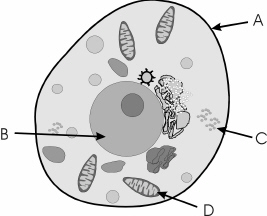 Letter “B” represents which part of an
animal cell? a. | cell membrane | c. | chloroplasm | b. | cell wall | d. | nucleus |
|


